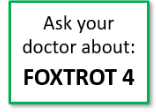The FOxTROT Programme
What is the difference between FOxTROT and current bowel cancer treatments?
For many years, the standard treatment for patients with bowel cancer has been to have surgery to remove the tumour. Surgery is then followed by giving a course of anti-cancer medicine for most patients. The aim of the anti-cancer medicine (chemotherapy) is to kill off any remaining cancerous cells not removed by the surgery.
Our FOxTROT 1 research showed that giving some chemotherapy before surgery (called ‘neoadjuvant’ chemotherapy) was safe for bowel cancer patients, reduced complications following surgery and reduced the chances of their cancer coming back. The approach has become a standard treatment option under NICE (the National Institute for Health and Care Excellence) guidelines for those patients who are younger and fitter and who have fewer other medical conditions.
We now want to find out if the neoadjuvant approach can:
- offer better treatment for more mature patients or those with other significant medical conditions – FOxTROT 2 and FOxTROT 5.
- be ‘intensified’ to make it even more effective for younger, fitter patients – FOxTROT 3
- can be used for a more targeted treatment for certain patients with bowel cancer – FOxTROT 4

You can find more information about how we use your data here.
FOxTROT Trial Arms – Key Differences
The key difference between FOxTROT 2 and standard treatment is not in the surgery or the chemotherapy medicines used, but WHEN they are used. Instead of undergoing the surgery first, followed by chemotherapy, some patients in FOxTROT 2 will receive part of the chemotherapy before surgery and some patients will receive the standard approach of having surgery first.
The key difference in FOxTROT 3 is not in the surgery but the neoadjuvant chemotherapy medicines used. Patients in the FOxTROT 3 approach will receive either ‘intensified’ neoadjuvant chemotherapy (three chemotherapy medicines) or ‘non-intensified’ neoadjuvant chemotherapy (two chemotherapy medicines). Patients will receive further chemotherapy after surgery.







